When I was a student in middle school and high school, life was simple: go to class, write down the assignment, complete the warm up, listen to the teacher, take notes, read the assigned passages, answer the questions, turn in your work, and repeat tomorrow.
Was every class like this? Didn’t any class use other methods of teaching? Well, yes…
- My 6th grade history teacher had us research someone from history and told us to dress up as that person to give our presentation from that perspective.
- My 7th grade science teacher was slightly obsessed with Bill Nye the Science Guy, so we experimented with science often after watching his shows.
- My 9th grade algebra teacher used Gumby the cartoon character in many of her lessons to help us visualize the different strategies.
- My 10th grade physics teacher constantly had us working on projects either on our own or with a partner in order to learn how things worked.
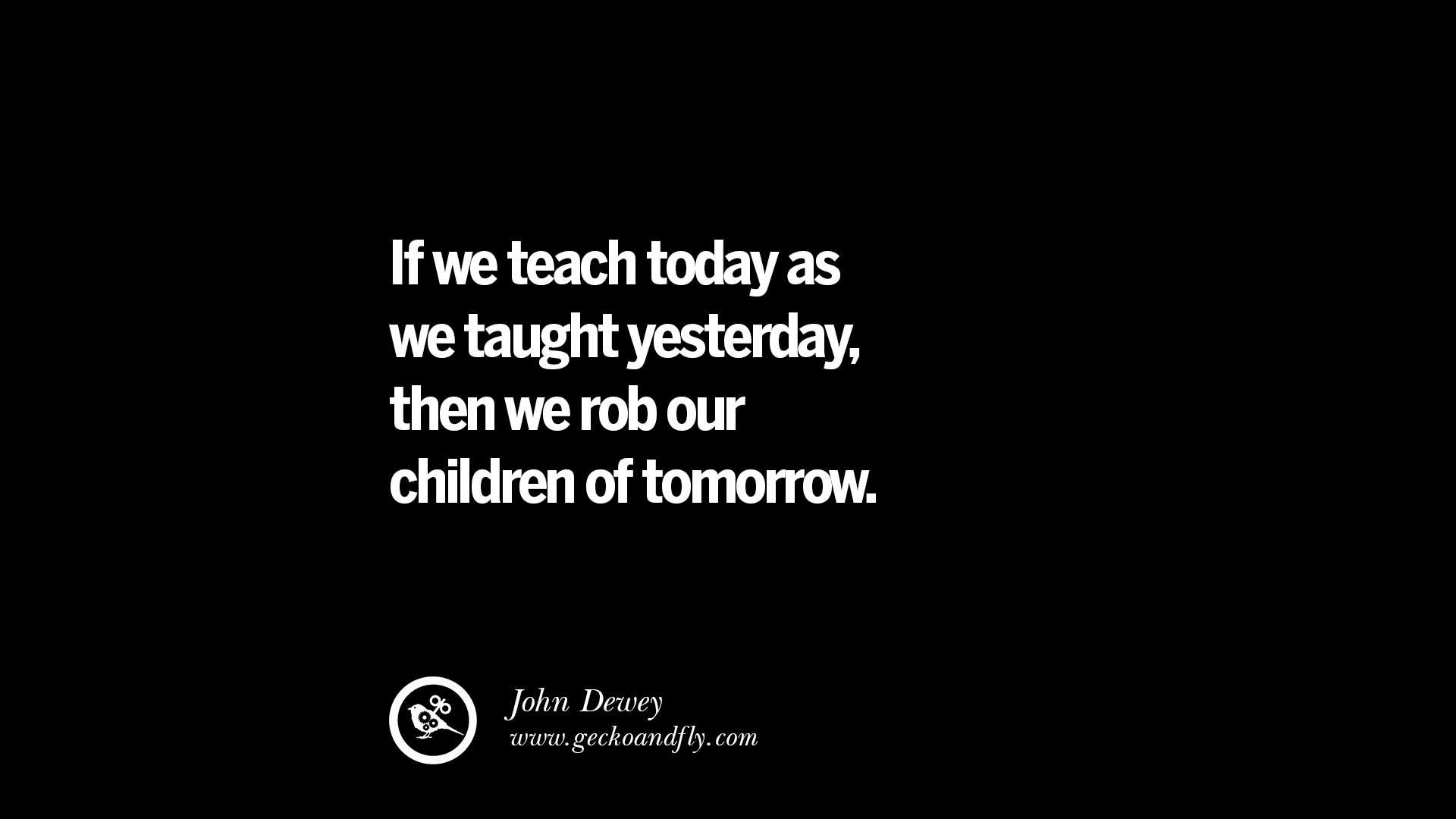
These teachers stand out. They made learning engaging, and in a few cases, empowering for me. These teachers were innovative. These teachers made me want to teach, too (although I didn’t realize it at the time).
What is innovation and why does it matter to me?
Why were those teachers innovative? What made them different? Easy: they stood out, they made sure each student was learning, and they tried new things. I didn’t experience that often when I was in school, so the times when I did are especially meaningful.
Earlier this school year, I was asked (by our curriculum director, Melissa Bosley) to take part in an Innovative Teaching Academy through our region’s education service center, Region 12 which covers Central Texas. This program is broken down into three phases, which will help today’s teachers better connect and empower the students of this generation. It will help today’s teachers make learning meaningful to their students.
Innovation in teaching is about reaching every student.
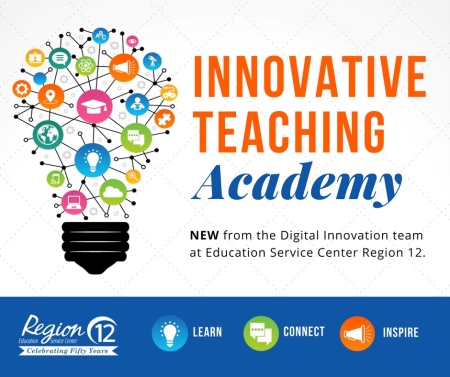
I immediately jumped at the chance to improve as a teacher. I have since completed phase one, Learn, of the program, and I’m on to phase two!
I have to pause right here and thank the wonderful leaders of this Academy: Cory Camp, Andi McNair, and Josh Essary. They have made this experience exciting, enriching, and empowering — I truly enjoy this program and value everything I’ve learned in it.
Phase One
During the first phase of the training, teachers participate in “learning experiences. These are professional development training with hands-on outside learning opportunities (O.L.O.) to learn through doing.
To “graduate” from this step, we need to take part in at least 30 hours of training. The best part is that we get choices! There are numerous learning experiences available, but we only need to choose the ones we’re interested in, which will in turn help us choose our focus for the next two phases.
My focus: empowering students.
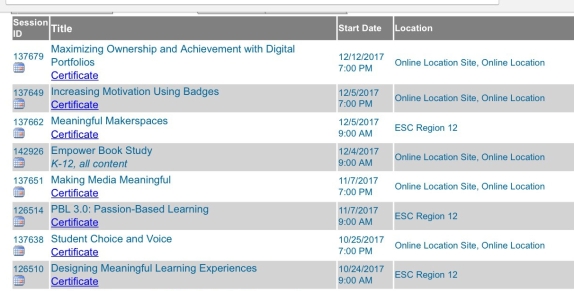
Every major project or undertaking should have a significant question (we even teach that to students before they start research), so I figured out mine…
How can I empower students to learn without me leading them?
Each of these classes helped me answer that question, but I’ll narrow it down to my two favorites (although that’s not quite fair since we’re in the middle of the book study).
Designing Meaningful Learning Experiences and Student Choice and Voice — State standards mandate what we have to teach, and many schools follow a YAG (year at a glance) to show when they have to teach it. If we’re lucky, we get a choice in how we teach these lessons. Therefore, why shouldn’t students receive choices, too (especially when they impact the students on a deeper level)?
In order to incorporate more meaningful experiences into our classroom, I wanted help from my students, and they wanted to help create their own choices. We keep writer’s notebooks, and every student has personal writing goals each grading period within these notebooks. One major problem they faced: what do I write about when I get stuck?
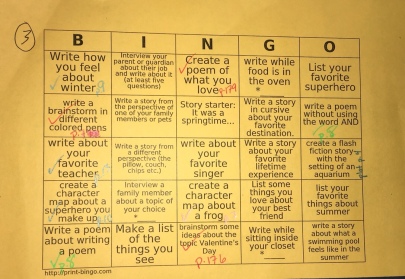
BINGO! That’s it! I asked the students to create bingo ideas that would help us create Writing Bingo. I honestly didn’t know what to expect, but I was blown away by their creativity in this task. Not only that, but they’re actually getting Bingo and achieving their goals!
Even though quite a few students have completed a Bingo, they are reluctant to share their voice on our class blog. However, I managed to talk one student into sharing hers today, so she’ll work on that and have a post up next week!
(Update 2/19/18 — Hers is up today! Check it out here!)
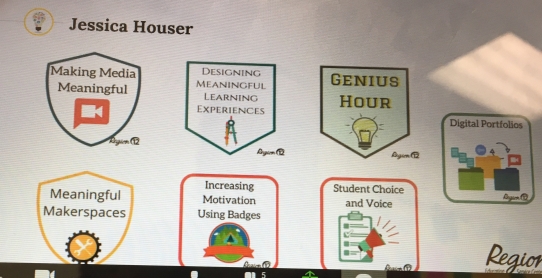
Phase Two
The Innovative Teaching Academy seems a bit more complicated now that I’m in phase two. However, these classes have shown me ways to make phase two possible.
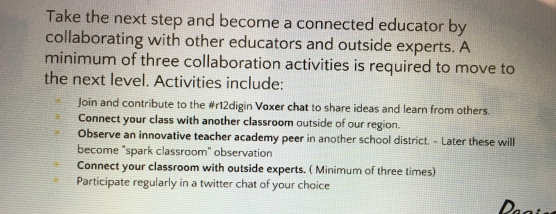
I already participate regularly in Twitter chats for writing and education, so continuing to do so isn’t a problem. I can sometimes even be found out-of-state! (These are listed using Central time since that’s the timezone I’m in.)
- Sunday
- #sunchat ~8am
- #TXeduchat ~ 8pm
- #BCedchat ~ 9pm
- Monday
- #teachwrite (on the first Monday of each month) ~ 6:30pm
- #NYedchat ~ 7pm
- KSedchat ~ 8pm
- #ALedchat ~ 9pm
- Tuesday
- #5thchat ~ 7pm
- #2ndaryELA ~ 7pm
- #MTedchat ~ 9pm
- Wednesday
- #OHedchat ~ 8pm
- #WeirdEd ~ 9pm
- Thursday
- #whatisschool ~ 5pm
- #eduAR ~ 8:30pm
- Friday
- #engagechat ~ 7pm
- Saturday
- #EduGladiators ~ 10:30am
I’m working on connecting my class with outside experts. One expert will be a writer from our local writer’s group (after we meet again to discuss it). My students want an author to come speak to them in order to talk about the writing process and their struggles and successes with it.
One of my students in the Teen Leadership elective that I teach wanted to talk to a football player. We are working on a face-to-face talk with former NFL player Quan Cosby, but in the meantime my student was able to research Quan and conduct an email interview. (Talk about a meaningful experience!)
Phase Three
The great thing about phase three is you don’t have to wait until you’re done with phase two to start it! This blog post helps count toward phase three for me, and so does my post about Bingo in the classroom.
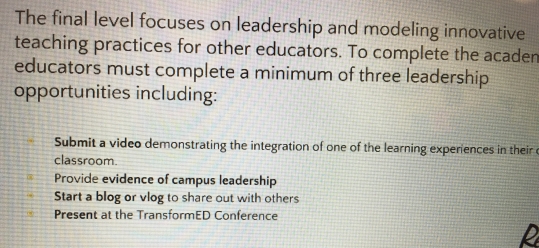
I submitted a proposal yesterday to present at the TransformED Conference. While I wait to hear from them, I’m also working with Melissa (our curriculum director) to see what I can do as far as campus leadership goes.
Reflection
One of the many tools I’ve gained from the ITA is reflection. I’m a firm believer in self-reflection, but I wasn’t holding my students to this to the same degree. We were introduced to this reflection tool, and my students love it! They’ve even started making up their own reflection questions at the end of class.
As far as my reflection thus far on the ITA, I simply have to see how far I’ve come in answering my question from above: How can I empower students to learn without me leading them?
I’ve learned that my students love to do things on their own. They make suggestions for our class in our Anonymous Suggestion Box (one of the ITA ideas). They create amazing things in their writer’s notebook by using the writing process. They take research into their own hands.

They are EMPOWERED! I simply have to make sure to keep moving in that direction as I continue through this process and beyond.
Proof of Empowerment
Last grading period one student wrote an acrostic poem about herself in her writer’s notebook. She is a quiet student in a large class. She is often overshadowed by others, and she doesn’t share her writing often.
However, I commented in the “Teacher Feedback” section of her writing goals when she turned it in that her poem was beautiful and that I would love to see her enhance it through the writing process. We all know that many students ignore teacher comments.
She didn’t.
Yesterday, she requested a writing conference. She was excited to show me that she had taken her acrostic poem through the writing process. She showed me where she added similes, imagery, and where she had changed capitalization for emphasis.
I hope you get as many goosebumps as I did after reading this incredibly powerful poem from a 7th grade girl.
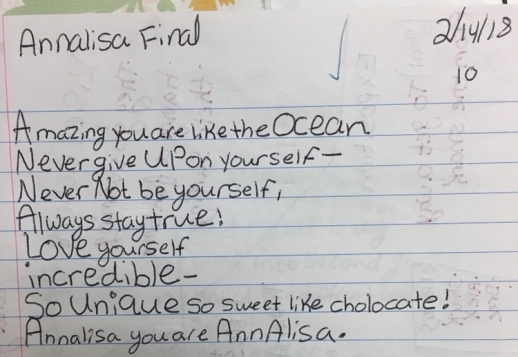
Your Turn…
Have I mentioned anything you want to try? How do you empower your students? Please feel free to share with me in the comments.
Oh, my, JJ – What the world needs are more young, passionate and inspired teachers like you! And, thank you for being a part of the Bosque Valley Writers so we members can enjoy your ideas and blog.
LikeLiked by 1 person
Thank you, Abby! I am loving BVW, and I can’t wait to get to know everyone better!
LikeLike
Jessica, I don’t teach students as such but do write and deliver sermon messages and teaching. Your ideas here are quite refreshing and are giving me new things to consider. I may be able to implement some of them in my church setting. Thanks for writing this out with the visual results. I will be praying into these and see how Holy Spirit leads.
I was very impressed with the responses from your students. They grabbed hold and carried the suggestions through to the goal. Congratulations.
LikeLiked by 1 person
Thank you for taking the time to read this even though you’re not in a classroom setting. I like to think that God wants us to be empowered too, so I hope you’re successful in your venture that direction.
I am right here with you on being impressed with my students! I definitely want to keep encouraging them.
LikeLike
Jess!!!! I love thus blog post!! I have loved seeing your dedication and passion for transforming the learning experiences in your classroom! You are exactly the kind of educator we were thinking of when we designed the Innovative Teaching Academy. I can’t wait to see what you do and how you inspire educators around you! Keep empowering!!!
LikeLiked by 1 person
Thank you, Cory! My students are loving the changes as we go. They definitely love that I listen to their suggestions, too.
We’re currently working our way through the writing process with an expository essay, and they’re using the magnetic board to visualize progress as they go. It’s a success for sure!
LikeLike